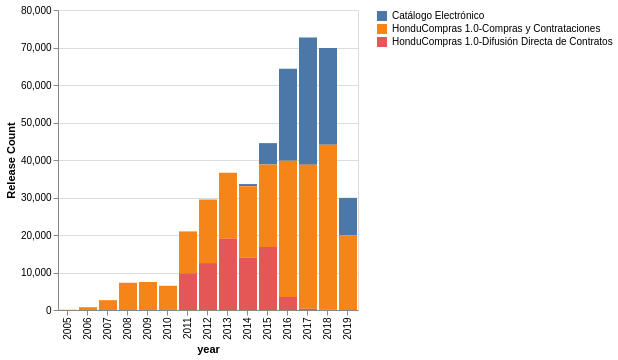Implementing an open contracting portal in Honduras

With this article, we examine technical progress on open contracting data publication and tool development in Honduras. We remain attentive to the challenges faced by civil society and media in the country to achieve sustainable reforms. Converting technical progress into meaningful change will be the endeavour ahead for our partners in Honduras.
Last April, the State Procurement Agency of Honduras (known as ONCAE, Oficina Normativa de Contrataciones y Adquisiciones del Estado) released their procurement data in OCDS format.
ONCAE is the public office that regulates public procurement in the country, and provides resources and guidance to all government offices and entities as well as government suppliers. ONCAE is also responsible for managing HonduCompras, an online platform used to manage public procurement and to release information, for both potential suppliers for the government and for the general public.
ONCAE is in the process of moving to a new e-procurement system (Honducompras 2.0), designed to overcome some of the issues they have with their current systems, like the lack of traceability of the contracting processes and interoperability with the national financial systems. These systems are up to 10 years old, operate within different stages of the procurement process and were not initially designed to talk to each other (HonduCompras 1.0 being one of them).
Even when having a solution in the long term, the data stored in the current systems is more than valuable for transparency and accountability. When having sources with disparate data, using a data standard can help: unifying the data through well-defined fields and structures can help users to understand it and use it, plus other benefits such as the availability of tools and methodologies.
In this post, we’ll go through ONCAE’s OCDS dataset and highlight some of the good examples in the making and publication of OCDS data. We will also discuss some of the points for improvement, and the steps this publisher is planning to take. At the end, we’ll share future plans of the government of Honduras related to open data.
We want to emphasize that the journey to get to this point has been following a winding road. Apart from the technical aspects, it is the result of the collaborative efforts of several international organizations including the World Bank and USAID, and in-country champions that have navigated politics and were able to put this topic up in the priorities of the current government. We especially want to thank the wonderful Alfredo Cantero, our friend and partner who passed away last year. His support to open contracting made it possible to include in Honduras budget law the open contracting principles to be followed by procuring agencies across the country.
What data does Honduras publish?
Published data is extracted from two sources. The main one is HonduCompras 1.0. The second is the Electronic Catalog (Catálogo Electrónico), in which public offices can order goods and services from government suppliers that have been awarded within a Framework Agreement. The information is extracted daily from both systems, converted to OCDS and uploaded to ONCAE’s open data portal as bulk download files in JSON, CSV and Microsoft Excel formats. The variety of data formats is a great choice, because it makes the data available for more potential data users. The range of dates covered by the dataset depends on the source system and module (from 2005 for the main module in HonduCompras 1.0).
Besides the OCDS core fields, ONCAE uses several OCDS extensions. Most of these have been used to provide information of contracting processes that are not included in OCDS core, such as Contract Suppliers and Multiple Buyers – Contract Level (suppliers and buyers in the Contract stage, for framework agreements), Guarantees (provided by tenderers, suppliers and buyers to ensure compliance with certain obligations), Member Of (to specify organizational hierarchies), Participation Fees (to include fees of bidding documents), and Budget Breakdown (for processes with multiple financial sources). Others provide metadata that will be useful in the future to trace the origin of the data, like Release Source and Release Publisher. It is worth noting that the community extensions Guarantees and Release Publisher have been reused, which demonstrates the value of publishers creating and sharing extensions; and the Release Source extension, created by them, is being added in the community extension list.
Transparency: what can the data reveal about public procurement?
The following graphs illustrate what we can learn about public procurement in Honduras through the published ONCAE OCDS data. The figure below shows the number of OCDS releases per year, by source system. There are three sources instead of two: data from HonduCompras is divided between the Procurement Data Release module (Difusión de Compras y Contratos) which contains data from procurement processes, and the Direct Contract Release module (Difusión Directa de Contratos), which allows public officers to enter contract data that has not been managed through HonduCompras. The source specification has been made because of notable differences in data availability between the modules, as we will see later.

The Direct Contract Release module has been discontinued, so we can see data from it up to 2016 only. From the Procurement Data Release module, we can see that the number of releases (and therefore, contracting processes published via HonduCompras) is increasing year by year.
The items classification scheme in HonduCompras and other procurement systems in Honduras is based on the UNSPSC standard for the classification of goods and services from the United Nations. Using UNSPSC (one of the classification systems recommended in the OCDS documentation) is another smart choice that can be very useful for analysis, since: a) it allows comparability between items published in other countries also based on UNSPSC, and b) its codification uses a hierarchical approach in which categories can be extracted from the codes themselves:

| 10000000 | Segment | Live Plant and Animal Material and Accessories and Supplies |
| 10100000 | Family | Live animals |
| 10101500 | Class | Livestock |
| 10101518 | Commodity | Alpaca |
We can demonstrate the use UNSPSC codes using the figure below, that shows the top 10 UNSPSC segments by number of tenders:

The challenges
Data users need to be aware of shortcomings and issues that may be present. For the current OCDS publication, the main issue is the relatively low coverage of the public procurement universe and absence of key information, like award and contract dates, tender details and items procured. In the table below, we show a few OCDS fields of interest along with the coverage for the section they belong to.
| OCDS Section | OCDS Path | HonduCompras: Procurement Data Release Module | HonduCompras: Direct Contract Release Module | Electronic Catalog |
| tender | procurementMethod | 13% | – | – |
| award | date | 0% | – | – |
| awards | items | 86% | 4% | – |
| contracts | items | – | 55% | 94% |
| contracts | dateSigned | 78% | 0% | – |
| contracts | period/startDate | 22% | 100% | 100% |
As we see, there are different degrees of coverage for each source, because there are different degrees of data availability for each field, depending on the source. In HonduCompras’ Direct Contract Release module, only 55% of the contracts specify the items procured. Also in HonduCompras, contract dates are partially filled: the Procurement Data Release module is missing start dates for most processes and the Direct Contract Release module lacks signing dates.
Even considering the missing dates, the available ones should be enough to calculate significant indicators, like public spending by year. The figures below show the total contract amounts for each source, for all contract amounts specified in Honduran Lempiras (HNL) only (for simplicity):

Although the graphs here are divided by source, it should be easy to integrate the data into a single graph and add the amounts expressed using foreign currencies to get a global view of the spending in procurement.
Another issue is the missing information of tenders in the Direct Contract Release module. In the module it is possible to link to a previously published tender in HonduCompras, but only 12% of all contracts are linked to a tender, which could mean either missing tender information or broken links between tenders and contracts.
What’s coming next
The publication is the first step of a plan from the Government of Honduras to integrate information from several legacy systems to improve the transparency of public procurement across all stages of the contracting cycle. The first phase of the plan is to unify the legacy information in a single public database, which is done through the OCDS publication. This will be accomplished with the launch of their new Open Contracting Portal. The next phase is replacing some of these legacy systems with a new e-procurement system, designed to interoperate with the financial systems in the country. Once all of this information is published using a standardized format, the integrated database would be a rich source of both historical and current up-to-date information. This project is being carried out by the Government of Honduras with technical assistance of the World Bank funded by USAID, and support from the Open Contracting Partnership.
The new e-procurement system announced last May is called HonduCompras 2.0. HonduCompras 2.0 will include more field data inputs to increase the amount of structured data collected, enable the tracking of contracting processes from planning to contract signing, and include a link to SIAFI, the national financial system managed by the Finance Secretariat (SEFIN) that can add budget and financial implementation (payments) data to the data publication. HonduCompras 2.0 is currently being piloted in a selected number of government agencies.
The work to generate OCDS data from HonduCompras 2.0 has started already, so the OCDS data will be added as a new source to their open data portal. SEFIN, also with the technical assistance of the World Bank, is working on complementing ONCAE’s OCDS publication with planning and financial implementation data.
CoST, the Infrastructure Transparency Initiative, is supporting the Government of Honduras with the development of a new version of SISOCS, the online portal that enables citizens to keep track of public infrastructure works managed by several public entities and offices. SISOCS will include the publication of contracting data related to infrastructure projects in OCDS format, and will be one of the first portals publishing infrastructure project data in OC4IDS, the open data standard developed by CoST and Open Contracting Partnership. Commitments made in Honduras OGP’s action plan have been crucial to arriving at these results.
Honduras’ open contracting portal
The Government plans to launch their Open Contracting Portal in 2020, which will allow the general public to access contracting information in a user friendly way. The portal consumes OCDS data produced by both ONCAE and SEFIN, and will display data of individual contracting processes, suppliers and buyers, as well as dashboards with visualizations and aggregated reports.
These visualizations are meant to provide a quick and easy-to-understand overview of the data for the public to interact with and tailor to specific reports according to their interests and needs. ONCAE hopes this will attract data consumers and researchers but also citizens looking for government transparency data.
The Secretariat of General Coordination of Government has committed to make efforts on publicity and promotion of data use with academia and NGOs to seek better impact.
The portal will also add an API to retrieve and search data in a programmatic way, which is a nice complement for ONCAE’s publication. All the portal’s source code is open source and it is meant to consume OCDS data, so it should be re-usable for other publishers.